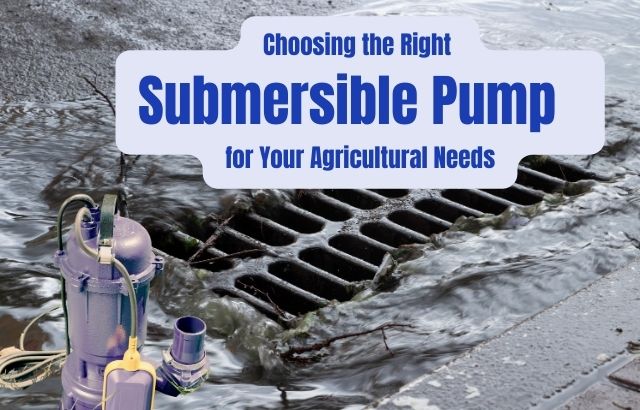In the realm of agriculture, where water is the lifeblood of crops, livestock, and livelihoods, the choice of the right submersible pump can make a significant difference in efficiency, productivity, and overall success. Whether you’re irrigating fields, draining flooded areas, or managing water for livestock, selecting the appropriate submersible pump is crucial. In this blog post, we’ll delve into the key factors to consider when choosing a submersible pump for your agricultural needs.
Understanding Your Requirements
The first step in selecting the right submersible pump is to understand your specific agricultural requirements. Consider factors such as the size of your farm, the type of crops or livestock you’re managing, the water source (well, pond, river, etc.), and the terrain of your land. This initial assessment will help you narrow down your options and ensure that you choose a pump that meets your unique needs.
Types of Submersible Pumps
There are various types of submersible pumps available on the market, each designed for specific purposes. Some common types include:
- Deep Well Pumps: Ideal for drawing water from deep underground wells, deep well submersible pumps are designed to handle high head and deliver water to the surface efficiently.
- Surface Water Pumps: These pumps are suitable for extracting water from ponds, lakes, or rivers and are often used for irrigation purposes. They are designed to withstand varying water levels and can be submerged without damage.
- Sump Pumps: Used for drainage purposes, sump pumps are effective in removing excess water from flooded areas, basements, or low-lying fields. They are equipped with float switches to automatically activate when water levels rise.
- Effluent Pumps: Designed for handling wastewater and sewage, effluent pumps are essential for agricultural operations that generate organic waste or require drainage in areas prone to flooding.
Key Considerations
When choosing a submersible pump for your agricultural needs, several key factors should influence your decision:
- Flow Rate: Determine the required flow rate based on the size of your irrigation system or the volume of water needed for your crops or livestock.
- Head Pressure: Consider the vertical distance the pump needs to lift water, known as head pressure, to ensure sufficient water delivery to your fields or storage tanks.
- Power Source: Decide whether you prefer electric-powered pumps or those powered by alternative sources such as solar energy or diesel engines, depending on the availability of power on your farm and your sustainability goals.
- Durability and Reliability: Invest in a high-quality submersible pump that is built to withstand harsh agricultural conditions, including exposure to water, debris, and chemicals, to ensure long-term performance and minimal downtime.
- Maintenance Requirements: Choose a pump that is easy to maintain and service, with accessible parts and clear instructions for troubleshooting common issues, to minimize disruptions to your operations.
Conclusion
In conclusion, selecting the appropriate submersible pump is pivotal for enhancing water efficiency, maximizing crop yields, and ensuring the overall success of agricultural endeavors. By comprehensively understanding your specific requirements, exploring diverse pump options, and considering vital factors such as flow rate, head pressure, power source, durability, and maintenance needs, you can make a well-informed decision tailored to your agricultural needs. With a commitment to innovation and quality, Kulkarni Pumps Private Limited stands out as a leading pioneer, offering aluminum cast pumps and 100% stainless steel submersible pumps. With a remarkable production capacity and a dedication to advanced technology and safety standards, Kulkarni Pumps Private Limited continues to establish itself among the top brands globally, contributing to the prosperity and efficiency of agricultural operations worldwide.










 KPPL about being flexible, adapting to change, and always staying ahead of the curve. It's about being reliable, producing products that people can count on year after year. And it's about being innovative, pushing the boundaries of what's possible, and making the submersible pump seeking world a groovier place in the process.
KPPL are like the cool grandparents of the submersible pump business world – they've got style, they've got substance, and they're not going anywhere anytime soon. So, let's give them a round of applause for their half-century of manufacturing magic!
KPPL about being flexible, adapting to change, and always staying ahead of the curve. It's about being reliable, producing products that people can count on year after year. And it's about being innovative, pushing the boundaries of what's possible, and making the submersible pump seeking world a groovier place in the process.
KPPL are like the cool grandparents of the submersible pump business world – they've got style, they've got substance, and they're not going anywhere anytime soon. So, let's give them a round of applause for their half-century of manufacturing magic!